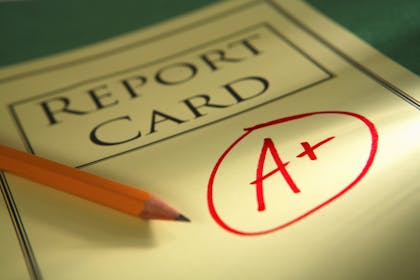Understanding your child's school report

If you received your child's primary school report you may have wondered what it actually says about their progress. Here's the lowdown to help you understand more about the system ...
This page contains affiliate links, which means we may earn a small amount of money if a reader clicks through and makes a purchase. All our articles and reviews are written independently by the Netmums editorial team.
When you get your child's school report, it may take a little while to get your head round it – especially if you've not seen one since your school days (some time ago now!)
So, as the national curriculum will undoubtedly have changed a bit since you were at primary school, we look at what breakdowns, comments and scores to expect on your little one's report.
Here's what to expect come the end of term ...
School reports for Nursery and Reception (EYFS)
Although schools can issue a school report for EYFS pupils how and when they like, there are some guidelines they're encouraged to follow.
Firstly, schools must have completed an EYFS profile for your child, which they must share with you and discuss with you in person if you prefer. It helps the school assess overall progress of pupils and also helps your child's next (year 1) teacher get to know your child's ability.
This profile should give you a written summary of your child's attainment against the early learning goals (ELGs). (For all 17 ELGs, see below.)
For each one, this should state whether the child is:
- emerging (1): your child is working below the expected level
- expected (2): working at the level expected for his age
- exceeding (3): working above the expected level.
At the end of reception year, your school should give you a written report which:
- states your child’s attainment against the ELGs
- summarises attainment in all areas of learning
- comments on general progress including the three characteristics of effective learning (playing and exploring, active learning and creative and thinking critically.)
- explains arrangements for discussing the profile.
Reports should:
- be specific to your child
- be concise and informative
- help to identify appropriate next steps.
School reports for year 1, 3, 4 and 5
Reports for year 1 – in fact, for each school year apart from 2 and 6 – are fairly standard.
There’s no specific design or format that schools have to follow for these years, although guidelines from the Department for Education specify that 'reports should be specific to the child, be concise and informative and help identify appropriate next steps for development.'
Some schools may even split the report across the academic year, for example to report on each term separately.
However, years 2 and 6 differ slightly because they take into account SATs results, and the end of key stage 1 and 2, respectively.
For more detail about your child's year 2 and year 6 report, read on ...
School reports for year 2 (key stage 1)
Reports issued at the end of year 2 (end of key stage 1) will differ slightly because they must include statutory teacher assessment judgments for reading, writing, maths and science.
If your child's in year 2, he will have taken the national curriculum tests, also known as SATs, in May. Your child’s teacher will use what they have seen in the classroom, as well as the results of these tests, to help judge how well he is progressing overall in these four skills/subjects: reading, writing, maths and science.
Work completed in year 1 will also be taken into account as well as year 2 work and performance in KS1 tests.
The teacher will then make their own judgement about how your child is progressing.
The idea is for the combined results to help teachers identify if your child needs further support, and to put this in place as early as possible.
Teachers mark the key stage 1 test papers. Some schools may choose to report the results to parents, alongside the overall teacher assessment judgements. If so, schools will report them using a scaled score.
• A scaled score of 100 means a child is working at the expected standard for the end of the key stage.
• A scaled score below 100 indicates that a child may need more support to work at the expected standard.
• A scaled score above 100 suggests a child is working above the expected standard for the key stage.
Understanding teacher assessment judgements
When making their teacher assessment judgements, based on how your child has performed over the last two years, teachers will assess your child as either:
• working towards the expected standard
• working at the expected standard, or
• working at greater depth within the expected standard.
Should I be worried if my child isn’t working at the expected standard?
If the scaled scores indicate that your child isn’t working at the expected standard, you shouldn’t worry.
It’s important to remember that these test results aren’t the whole picture. Teachers use the test results as one piece of evidence to help them arrive at their overall teacher assessment judgements and help them identify what additional support your child may need.
School reports for year 6 (key stage 2)
At the end of year 6 (the end of key stage 2) your child's school report must include statutory teacher assessment judgments for reading, writing, maths and science as well as national curriculum test results for reading, maths and grammar, punctuation and spelling.
If your child is in year 6, he will have taken the key stage 2 national curriculum tests, also known as SATs, in May. They are marked externally and the results sent to schools.
Before the end of the summer term, your child’s school will send you a report. The report will include both the test results and teacher assessment judgements.
Your child’s teacher forms the teacher assessment judgements. They judge what your child has achieved in maths, reading, writing and science at the end of year 6.
Together, these tests and assessments should provide you with a good sense of the standard that your child is working at in these subjects.
Your child will have taken tests in maths, reading and grammar, punctuation and spelling in May. The school will report these test results as a scaled score for each subject.
• A scaled score of 100 means a child is working at the expected standard for the end of the key stage.
• A scaled score below 100 indicates that a child may need more support to help them reach the expected standard.
• A scaled score above 100 suggests a child is working above the expected standard for the key stage.
The report your child’s teacher produces will paint a full picture of their strengths and where they might need extra support. This will help you and your child’s secondary school decide the best way to support your child as they move into year 7.
Understanding teacher assessment judgements
Your child’s teacher forms their judgements by assessing their work against the standards in reading, writing, maths and science.
For writing, they will report their decisions in terms of children:
• working towards the expected standard
• working at the expected standard
• working at greater depth within the expected standard
For reading, maths and science, they will report their decisions in terms of children:
• working at the expected standard
• having not met the expected standard.
Should I be worried if my child isn’t working at the expected standard?
There is no reason to worry. The end of key stage 2 assessments (SATs) are a way of making sure every child has mastered the basics when they leave primary education.
The results help teachers identify where children may need extra help and support as they move to secondary school. If you have any questions about your child’s results and what support they might need to do well in secondary school, you should speak to their teacher.
Some children won’t have taken the key stage 2 tests if their teacher thought they were working below the standard of the tests. If this is the case for your child, their teacher will assess them separately using different national measurements.
If this situation applies to your child, then you should discuss any extra support they may need with their teacher.
Find the best school for your child!
Powered by 
What are the 17 early learning goals (ELGs)?
1. Listening and attention
2. Understanding
3. Speaking
4. Moving and handling
5. Health and self-care
6. Self-confidence and self-awareness
7. Managing feelings and behaviour
8. Making relationships
9. Reading
10. Writing
11. Numbers
12. Shapes, space and measures
13. People and communities
14. The world
15. Technology
16. Exploring and using media and materials
17. Being imaginative
For a tongue-in-cheek look at kids' school reports, click here.
Talk to other mums about school reports in our Coffeehouse chat forum, below ...


